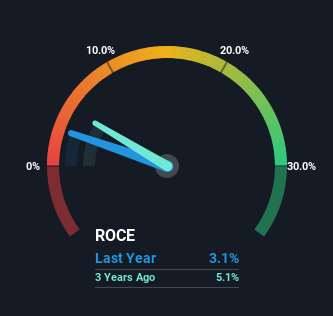Nippon Sheet Glass Company (TSE:5202) Is Finding It Tricky To Allocate Its Capital

What underlying fundamental trends can indicate that a company might be in decline? More often than not, we'll see a declining return on capital employed (ROCE) and a declining amount of capital employed. Basically the company is earning less on its investments and it is also reducing its total assets. On that note, looking into Nippon Sheet Glass Company (TSE:5202), we weren't too upbeat about how things were going.
What Is Return On Capital Employed (ROCE)?
Just to clarify if you're unsure, ROCE is a metric for evaluating how much pre-tax income (in percentage terms) a company earns on the capital invested in its business. The formula for this calculation on Nippon Sheet Glass Company is:
Return on Capital Employed = Earnings Before Interest and Tax (EBIT) ÷ (Total Assets - Current Liabilities)
0.031 = JP¥20b ÷ (JP¥981b - JP¥335b) (Based on the trailing twelve months to September 2024).
Thus, Nippon Sheet Glass Company has an ROCE of 3.1%. Ultimately, that's a low return and it under-performs the Building industry average of 7.6%.
Check out our latest analysis for Nippon Sheet Glass Company

Above you can see how the current ROCE for Nippon Sheet Glass Company compares to its prior returns on capital, but there's only so much you can tell from the past. If you're interested, you can view the analysts predictions in our free analyst report for Nippon Sheet Glass Company .
The Trend Of ROCE
There is reason to be cautious about Nippon Sheet Glass Company, given the returns are trending downwards. About five years ago, returns on capital were 4.6%, however they're now substantially lower than that as we saw above. On top of that, it's worth noting that the amount of capital employed within the business has remained relatively steady. Since returns are falling and the business has the same amount of assets employed, this can suggest it's a mature business that hasn't had much growth in the last five years. If these trends continue, we wouldn't expect Nippon Sheet Glass Company to turn into a multi-bagger.
The Bottom Line On Nippon Sheet Glass Company's ROCE
In summary, it's unfortunate that Nippon Sheet Glass Company is generating lower returns from the same amount of capital. Long term shareholders who've owned the stock over the last five years have experienced a 43% depreciation in their investment, so it appears the market might not like these trends either. Unless there is a shift to a more positive trajectory in these metrics, we would look elsewhere.
Nippon Sheet Glass Company could be trading at an attractive price in other respects, so you might find our free intrinsic value estimation for 5202 on our platform quite valuable.
While Nippon Sheet Glass Company isn't earning the highest return, check out this free list of companies that are earning high returns on equity with solid balance sheets.
Valuation is complex, but we're here to simplify it.
Discover if Nippon Sheet Glass Company might be undervalued or overvalued with our detailed analysis, featuring fair value estimates, potential risks, dividends, insider trades, and its financial condition.
Access Free AnalysisHave feedback on this article? Concerned about the content? Get in touch with us directly. Alternatively, email editorial-team (at) simplywallst.com.
This article by Simply Wall St is general in nature. We provide commentary based on historical data and analyst forecasts only using an unbiased methodology and our articles are not intended to be financial advice. It does not constitute a recommendation to buy or sell any stock, and does not take account of your objectives, or your financial situation. We aim to bring you long-term focused analysis driven by fundamental data. Note that our analysis may not factor in the latest price-sensitive company announcements or qualitative material. Simply Wall St has no position in any stocks mentioned.
About TSE:5202
Nippon Sheet Glass Company
Engages in the manufacture and sale of glass and glazing products in Japan, Europe, North America, and South America.
Undervalued with moderate growth potential.
Similar Companies
Market Insights
Community Narratives



